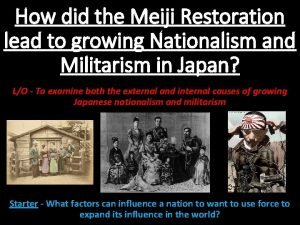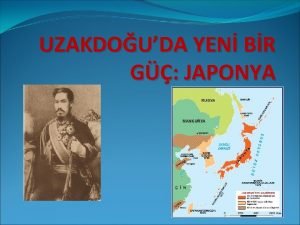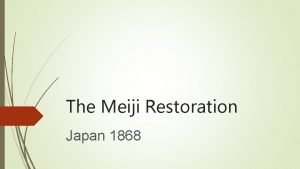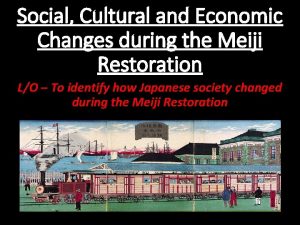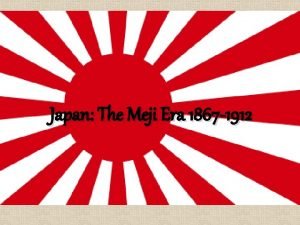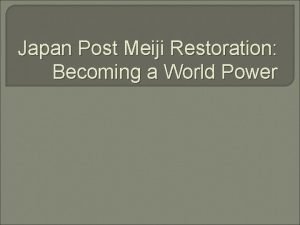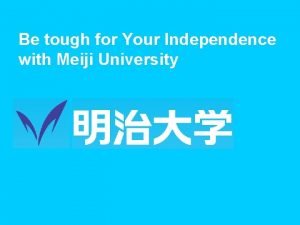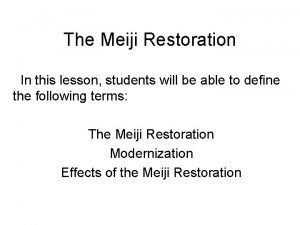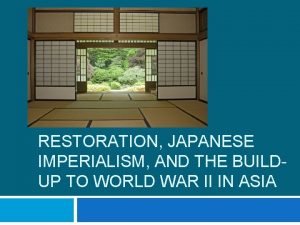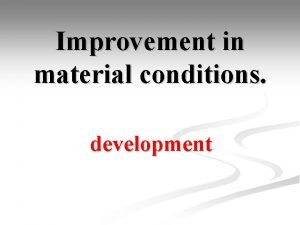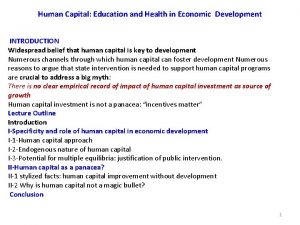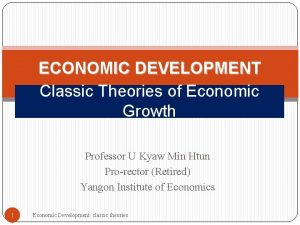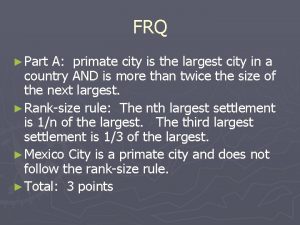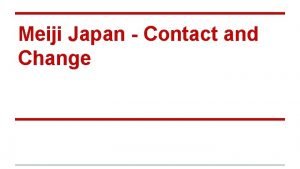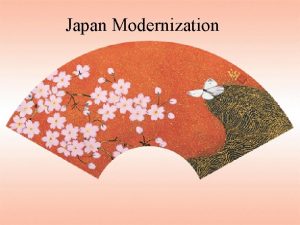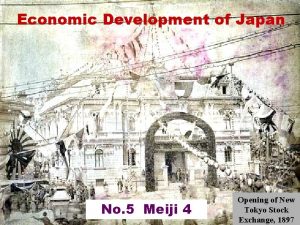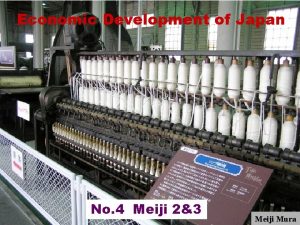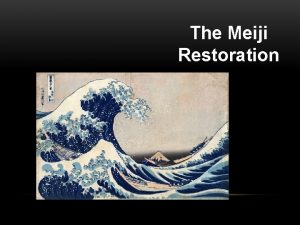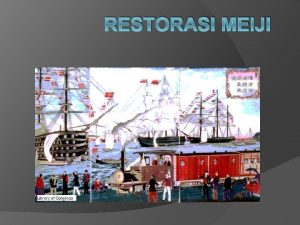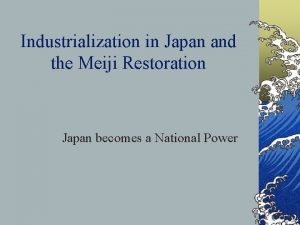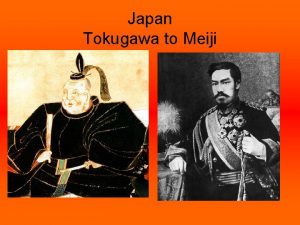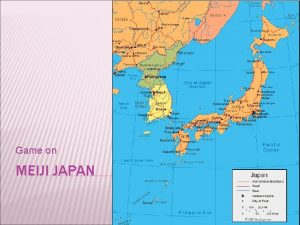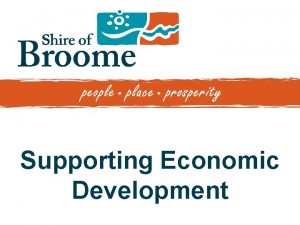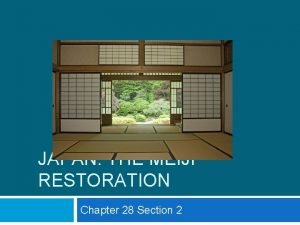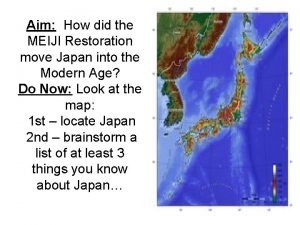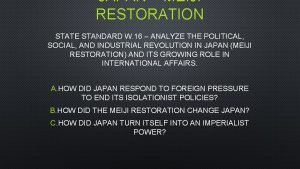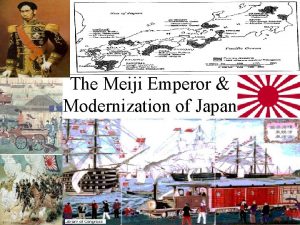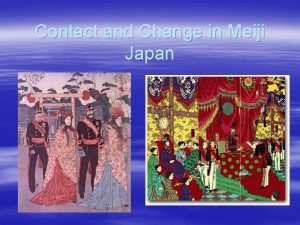Economic Development of Japan No 3 Meiji 1





















- Slides: 21

Economic Development of Japan No. 3 Meiji 1

PP. 40 -42 Second Arrival of the West and End of Edo • US Commodore Perry and his “Black Ships” came to Edo Bay and used military threat to open up Japan (1853 -54). • Trade with the West began under “unequal” treaties of 1858 ( no tariff right, no court right) which brought social and economic changes. • Fights over pro- vs. anti-foreigners, and pro- vs. anti-Bakufu began, eventually toppling Bakufu in 1867 and accepting open trade. Support Bakufu 佐幕 Antiforeigner Black Ships 攘夷 Open door Choshu Han Satsuma Han Odaiba No. 3 (Bakufu’s fortified island) X 1862 1865 1866 Meiji Gov’t 開国 M. C. Perry (1794 -1858) Support Emperor 尊皇 France U. K.

Hans that produced many leaders (Alternative place names in parentheses)

Signing of Japan-US Friendship Treaty in Yokohama, Mar. 1854 Perry’s Entry into Edo Bay 1853 -54 Edo New forts (1854) Yokohama Uraga Kurihama Stop line July 1853 (4 ships) Attack line O-daiba (forts) Feb. 1854 (7 ships)

Japan-US Friendship Treaty (Mar. 1854) Officially: Convention of Peace and Amity between the USA and the Empire of Japan (or the Kanagawa Treaty) 1. Two nations shall build permanent friendship. 2. Shimoda & Hakodate shall be opened as ports for supplying necessities for US ships. 3. Shipwreck shall be rescued. 4. Freedom and rights for Americans in shipwreck. 5. Americans may travel in limited areas around two ports. 6. Additional requirement shall be discussed by two sides. 7. Exchange of coins & goods is allowed subject to Japanese law. 8. Fuel, food & coal shall be supplied through government and in non-excessive amounts. 9. US shall enjoy all privileges given to other nationalities [MFN]. 10. In emergency, other ports may be used for taking shelter. 11. US representative shall be stationed if necessary after 18 months. 12. Ratify this treaty within 18 months.

Japan-US Treaty of Amity & Commerce (July 1858) 1. Mutual exchange of diplomatic missions. 2. US shall mediate disputes between Japan and Europeans. 3. Kanagawa, Nagasaki, Niigata, Hyogo, Edo & Osaka shall be additionally opened. Americans may reside and freely trade without official interference in designated port cities. 4. Official inspection is required for export & import goods. 5. Rules about monetary exchange. 6. American criminals are judged by the US Consulate; Japanese criminals are judged by Japanese court. Appeal is possible. Government shall not intervene in trading activity. 7. Americans may travel in designated areas around open ports. 8. Freedom of religion. 9. Mutual assistance in criminal arrest & detention. 10. Japan may hire American experts for purchasing ships & weapons, and for other professional services. 11 -14. Attachment, revision, ratification, etc. US Consul General Townsend Harris


Westerners’ settlement Japanese merchants’ street PP. 41 -42 Fake color photos of early Yokohama Trade 1876 -80 Resumed International Trade • Open ports (1859): Yokohama, Nagasaki, Hakodate, Niigata; Hyogo (delayed, 1867) • Unequal treaties with West vs. no internal travel rights foreigners • Rise of Yokohama merchants • Beginning of rapid westernization and technology import • Inflation, relative price changes, and rise and fall of industries To US From UK Steel Pier (1894)

Cumulative history, Edo achievements, national unity and nationalism Japan’s economic growth was driven primarily by private dynamism while policy was also helpful Private-sector dynamism and entrepreneurship (primary force) Appropriate policy support (supplementary) P. 56 Rapid industrialization especially in Meiji and post WW 2 period Policy was generally successful despite criticisms: --Power monopoly & close linkage with big businesses --Privatization scandal, 1881 --Excessively pro-West --Unfair by today’s standard

Meiji Government: Radical Reformist P. 43 Shifting national goals: Avoid colonization by the West Rapid modernization and Westernization Become “first-class” nation on a par with West • Political goal - abolish feudalism and class society; introduce Western style constitution and parliament • Economic goal - industrialization based on rapid adoption of Western technology • External goals - (1) revise unequal treaties as soon as possible; (2) modernize army & navy, establish “sphere of influence” around Japan Fukoku Kyohei (富国強兵) - Enrich the country, strengthen the military Shokusan Kogyo (殖産興業) - Increase production, encourage industry

Kido Yamaguchi Ito Okubo P. 44 Iwakura Mission (Dec. 1871 -Sep. 1873) --Organized quickly after abolishing hans --Half the cabinet went - Iwakura (Ambassador), Okubo, Ito, Kido, Yamaguchi (Deputies) & other high officials (46); attendants (12), students (49); total 107 members Purpose 1: Start re-negotiating unequal treaties (failed) Purpose 2: Inspect Western systems and technology Official report with illustrations by Kunitake Kume (scholar) <Results> (1) Valuable inputs for policy making (2) Conflicts with “home-keeping” gov’t (leaders who stayed home)

Toshimichi Okubo (1830 -1878) PP. 44 -45 • Formerly, lower samurai from Satsuma Han • Top-down promoter of technology import and industrialization (after returning from Iwakura Mission) Okubo • Political influence—Councilor (Minister) of Finance; then Councilor of (newly established) Home Affairs • Policy measures: --Supporting zaibatsu (Iwasaki, Godai) to promote industries and import substitution (international shipping, etc) --Establishment of SOEs and research centers --Trade & industry exhibitions (for Japanese products) --Set up ministries, police and local governments --Send troops to Taiwan; suppress Saigo Rebellion Saigo

Okubo’s Back-to-Office Report after Iwakura Mission, 1874 “The strength of a country depends on the prosperity of its people which, in turn, is based on the level of output. To increase output, industrialization is essential. However, no country has ever initiated the process of industrialization without official guidance and promotion. ” Okubo’s Proposal on Constitutional Politics, 1873 “Monarchy is a thing of the past, but we are not yet ready for democracy. Moreover, the central government must have strong authority for the time being to carry out bold reforms. Thus, the most practical system Japan can now adopt is … constitutional monarchy.

Okubo’s Proposal Concerning Promotion of the Nation’s Fundamental Capacities, 1876 “…If we are to turn the tide around and correct the situation [of slow economic progress and trade deficits], we have no choice but to encourage private business and international trade by mobilizing effective policies to cultivate fundamental strengths of economic activities and expand commercial profit. If we do not regard this as the duties of the government and leave the matter to people’s own devices and simply wait for the results, will the decline ever stop? This is the most pressing of all national issues. Even though such policy may not be endorsed by the orthodox doctrine of political economy [Ricardian theory of comparative advantage], rules must be bent to respond to the urgent needs of our time. ”

Yataro Iwasaki (1835 -85) PP. 45 -46 三菱 • Seisho (政商) from Tosa, founder of Mitsubishi Zaibatsu • Shipping company--grew fast with government support (receiving gov’t ships, contract for military transport) • Established Nippon Yusen (NYK Line), fierce battle with Kyodo Unyu (anti-Mitsubushi company), 1883 -1885 • Expanded to many business areas: trade, banking, shipbuilding, coal, mining (later, more) Mechanical factory in Nagasaki, ca 1885 Bakufu’s Steel Mill in Nagasaki, transferred to Mitsubishi in 1884

Subsidies for Targeted Industry: The Case of Shipping & Ship Building • Navigation Promotion Law (1896) – subsidizing maritime transport operators if: - Operate international routes - Large ships over 1, 000 tons - Fast domestic ships These targets were raised in steps offering more incentives. • Shipbuilding Promotion Law (1896) – subsidizing building of steel ships over 700 tons (later 1000 tons).

Financial Structure of Nippon Yusen Ship Production Tons Subsidies Received by Shipbuilders Source: Yoshio Ando (ed), Databook on Modern Japanese Economy, 2 nd ed. , Univ. of Tokyo Press, 1979.

Eiichi Shibusawa (1840 -1931) P. 46 From Saitama Tomoatsu Godai (1836 -1885) From Satsuma Super business promoters -- but they did not form zaibatsu -Initially, anti-bakufu fighter -Next, assistant to last shogun -Works vigorously for MOF (invited by Meiji Government) -President of First “National” Bank” -Company builder and business coordinator for many years -Social contributions (See handout or go to museum) -Studies and builds human network in Nagasaki -Visits UK; realizes need to industrialize, writes report -In Osaka, helps to create copper co. , railroad, shipping co. , rice & stock exchanges, cham. of commerce, university, test centers, trading center, etc -SOE privatization scandal

P. 47 Rise and Fall of Merchants and Enterprises Q: Who were the main drivers of Meiji industrialization? A: All types of entrepreneurs including Edo gosho, Yokohama merchants, Meiji zaibatsu, and company boom millionaires. ► Survival game was severe: many entries, many exits ► Japan’s industrial revolution: from 1880 s to 1900 s ► Japan-China War, Japan-Russia War

Constitution and Parliament PP. 48 -50, 226 Western style legal system and functioning parliament were considered absolutely necessary to become a “first-class” nation Preferred model Desired speed Remark Gradualism (prepare during 1881 -90) Expelled opponents; Ito & his team drafted constitution Government (Okubo, Ito, Iwakura, K. Inoue) German constitutional monarchy Freedom & People’s Rights Movement; Fukuzawa, Okuma British (two-party) As soon as parliamentary possible system Tosa samurai, rich farmers; turned violent sometimes <First parliamentary debate, 1890> --Oppositions demanded “Budget Cuts, Reduce People’s Burden” (tax cuts on landlords) --Gov’t wanted active spending for military & infrastructure; declaring policy independence from party politics Emperor promulgates Constitution, 1889.

Foreign policy and military modernization (1) Revision of unequal treaties with West --Considered impossible until Japan became a Western style nation --Legal preparation (constitution & laws, functioning parliament) --Superficial imitation (eg. Rokumeikan) and excessive concession to the West were severely criticized by press and oppositions --Regaining customs rights 1899 -1911, court rights 1894 -99 (2) Military modernization and expansionism --Introduction of Western military technology and systems --Military budget (esp. battleships) was main cause of deficit --Invading Korea: provocation, victory over China’s Qing Dynasty (1894 -95), fighting with Russia (1904 -05), annexation of Korea (1910) --Japan colonized Taiwan after Japan-China war, 1895
 Japan before meiji restoration
Japan before meiji restoration Economic growth vs economic development
Economic growth vs economic development Difference between economic growth and economic development
Difference between economic growth and economic development Meiji restorasyonu ile japonya'da yapılan yenilikler
Meiji restorasyonu ile japonya'da yapılan yenilikler Meiji restoration
Meiji restoration Meiji restoration samurai
Meiji restoration samurai Shogunate
Shogunate Meiji restoration
Meiji restoration Latar belakang terjadinya restorasi meiji
Latar belakang terjadinya restorasi meiji Meiji university ikuta campus
Meiji university ikuta campus Meiji restoration definition
Meiji restoration definition Define meiji restoration
Define meiji restoration Tujuan koa kurenjo
Tujuan koa kurenjo Economic systems lesson 2 our economic choices
Economic systems lesson 2 our economic choices Japan's principal asset for promoting development was
Japan's principal asset for promoting development was Wake county economic development
Wake county economic development Economic social development
Economic social development Northern waterfront economic development initiative
Northern waterfront economic development initiative Human capital education and health in economic development
Human capital education and health in economic development Economic social development
Economic social development Classic theories of economic development: four approaches
Classic theories of economic development: four approaches Primate city frq
Primate city frq
